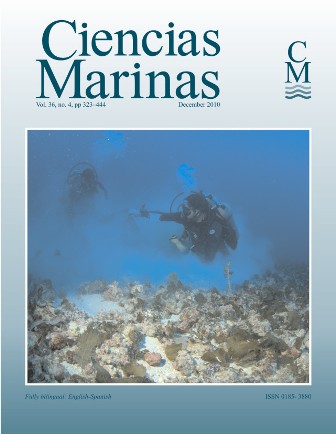Effect of Porphyridium cruentum polysaccharides on the activity of murine macrophage cell line RAW 264.7
Contenido principal del artículo
Resumen
Red algae are considered an important source of polysaccharides with potential immunomodulatory properties. Polysaccharides from the cell wall of the red alga Porphyridium cruentum can compose more than 50% of its biomass; however, little is known regarding its biochemical composition and phage-modulatory properties. Consequently, this study aimed to evaluate the effect of P. cruentum polysaccharides on tumor necrosis factor-alpha (TNF-alpha), interleukin-6 (IL-6), and nitric oxide (NO) production. Polysaccharides from P. cruentum were extracted and purified by N-cetylpyridinium bromide precipitation and characterized by Fourier transform infrared spectroscopy. The effect on the activity of murine macrophage cell line RAW 264.7 was examined by quantification of TNF-alpha, IL-6, and NO production using enzyme-linked immunosorbent assays. The results showed that the polysaccharides from P. cruentum induced TNF-alpha and IL-6 cytokine accumulation. The production of TNF-alpha was significantly higher than that in the control (bacterial lipopolysaccharide, LPS) when the concentration of polysaccharides was higher than 6.25 µg mL–1. The addition of polysaccharide levels above 25 µg mL–1 produced IL-6 levels ranging from 3.4 to 4 ng mL–1, which were comparable to the production of IL-6 induced by 50 ng mL–1 of LPS (3.3 ± 0.3). In contrast to IL-6 and TNF-alpha, NO production was only detected when polysaccharide concentrations were higher than 25 µg mL–1. These results indicate for the first time that polysaccharides from P. cruentum are strong cytokine inducers.
Las algas rojas se han considerado como una fuente importante de polisacáridos con propiedades inmunomodulatorias potenciales. Los polisacáridos de la pared celular del alga roja Porphyridium cruentum pueden componer más de 50% de su biomasa; sin embargo, poco se sabe sobre su composición bioquímica y sus propiedades inmunomoduladoras. Consecuentemente, el objetivo de este estudio fue evaluar el efecto de los polisacáridos de P. cruentum sobre la producción del factor de necrosis tumoral-alpha (TNF-alpha, de interleucina-6 (IL-6) y de óxido nítrico (NO). Los polisacáridos de P. cruentum se extrajeron y purificaron mediante una precipitación con bromuro de N-cetilpiridinio, y se caracterizaron por espectroscopía infrarroja con transformada de Fourier. El efecto de la actividad de la línea celular de macrófagos murinos RAW 264.7 fue examinada mediante una cuantificación de la producción de TNF-alpha, IL-6 y NO utilizando un ensayo por inmunoabsorción ligado a enzimas. Los resultados mostraron que los polisacáridos de P. cruentum indujeron la acumulación de TNF-alpha e IL-6. La producción de TNF-alpha fue significativamente más alta que la observada en el control (lipopolisacárido bacteriano, LPS) cuando la concentración de polisacáridos fue mayor a 6.25 µg mL–1. El añadir niveles de polisacáridos arriba de 25 µg mL–1 produjó niveles de IL-6 que fluctuaron entre 3.4 y 4 ng mL–1, lo cual fue similar a la producción de IL-6 inducida con 50 ng mL–1 de LPS (3.3 ± 0.3). En contraste a IL-6 y TNF-alpha, la producción de NO sólo fue detectada cuando las concentraciones de polisacáridos fueron mayores que 25 µg mL–1. Estos resultados indican por primera vez que los polisacáridos de P. cruentum inducen activamente la producción de citoquinas.
Las algas rojas se han considerado como una fuente importante de polisacáridos con propiedades inmunomodulatorias potenciales. Los polisacáridos de la pared celular del alga roja Porphyridium cruentum pueden componer más de 50% de su biomasa; sin embargo, poco se sabe sobre su composición bioquímica y sus propiedades inmunomoduladoras. Consecuentemente, el objetivo de este estudio fue evaluar el efecto de los polisacáridos de P. cruentum sobre la producción del factor de necrosis tumoral-alpha (TNF-alpha, de interleucina-6 (IL-6) y de óxido nítrico (NO). Los polisacáridos de P. cruentum se extrajeron y purificaron mediante una precipitación con bromuro de N-cetilpiridinio, y se caracterizaron por espectroscopía infrarroja con transformada de Fourier. El efecto de la actividad de la línea celular de macrófagos murinos RAW 264.7 fue examinada mediante una cuantificación de la producción de TNF-alpha, IL-6 y NO utilizando un ensayo por inmunoabsorción ligado a enzimas. Los resultados mostraron que los polisacáridos de P. cruentum indujeron la acumulación de TNF-alpha e IL-6. La producción de TNF-alpha fue significativamente más alta que la observada en el control (lipopolisacárido bacteriano, LPS) cuando la concentración de polisacáridos fue mayor a 6.25 µg mL–1. El añadir niveles de polisacáridos arriba de 25 µg mL–1 produjó niveles de IL-6 que fluctuaron entre 3.4 y 4 ng mL–1, lo cual fue similar a la producción de IL-6 inducida con 50 ng mL–1 de LPS (3.3 ± 0.3). En contraste a IL-6 y TNF-alpha, la producción de NO sólo fue detectada cuando las concentraciones de polisacáridos fueron mayores que 25 µg mL–1. Estos resultados indican por primera vez que los polisacáridos de P. cruentum inducen activamente la producción de citoquinas.
Descargas
Los datos de descargas todavía no están disponibles.
Detalles del artículo
Cómo citar
Abdala-Diaz, R. T., Chabrillon, M., Cabello-Pasini, A., Lopez-Soler, B., & Figueroa, F. L. (2010). Effect of Porphyridium cruentum polysaccharides on the activity of murine macrophage cell line RAW 264.7. Ciencias Marinas, 36(4), 345–353. https://doi.org/10.7773/cm.v36i4.1732
Número
Sección
Artículo de investigación
Este es un artículo de acceso abierto distribuido bajo una licencia Creative Commons Attribution 4.0, que le permite compartir y adaptar el trabajo, siempre que dé el crédito apropiado al autor o autores originales y la fuente, proporcione un enlace a Creative Commons licencia, e indicar si se realizaron cambios. Las figuras, tablas y otros elementos del artículo están incluidos en la licencia CC BY 4.0 del artículo, a menos que se indique lo contrario. El título de la revista está protegido por derechos de autor y no está sujeto a esta licencia. La escritura de licencia completa se puede ver aquí.

